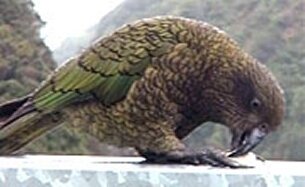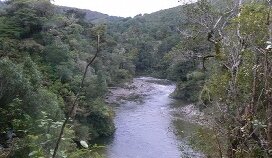

|
Tuesday 14 April. In May 2009, 22 tonnes of 1080 poison bait is to be aerially applied over 11,000 hectares around the western and eastern Hutt rivers to the north of Upper Hutt, including the catchment area for the capital's water supply. 1080 poison not only has links to endocrine disruption, (having the ability to affect the unborn foetus) it is also a male reproductive toxin. But Greater Wellington Regional Council spokesman, Murray Kennedy, says the public should not worry about 1080 getting into their drinking water. The US manufacturer's label from Tull Chemical Co. states, "Keep out of any body of water. Dispose (of 1080 contaminated wastes) at least one half mile from human habitation and water supplies." Wanganui Animal Control Products safety data sheet states "Avoid pollution of any water supply with the product (1080.) May be fatal if swallowed. This product is toxic to most wildlife. Birds and mammals feeding on carcasses of contaminated animals may be killed. Take measures to minimise the chance of baits entering any body of water. Apply the product only as specified by its label directions. Where practicable, the exposed bodies of all poisoned animals should be collected and destroyed by complete burning or deep burial at a landfill approved for hazardous wastes." According to NZ OSH requirements, 1080 cannot be applied to catchment areas from which water is drawn for human consumption without either prior permission of, or consultation with, the Medical Officer of Health of the district, or an appropriate authority. This same authority is also responsible for carrying out the poisoning operation. NZ 1080 National Network coordinator, Kate Winters, says, "The manufacturer's recommendations are there for good reason. They should be adhered to. Research on the chronic effects of trace amounts of 1080 on humans is severely lacking. Until this is done, the "precautionary principle" should apply. New Zealanders are suffering from a vast range of unusual symptoms, illness and disease, now more than ever before. Even our children are suffering from rare medical conditions and cancers. At the same time we are being bombarded by poisons. They are in the food we eat and in the water we drink. Scientific studies of 1080 on other species have concluded that the brain, heart, testes, epididymides and foetus are target organs for sublethal doses of 1080 poison. I am constantly contacted by rural residents throughout New Zealand, along with ex-pest control workers, whose health has been adversely affected by 1080. A 2008 report stated that the sperm count of NZ males is at an all-time low. And now the Greater Wellington Regional Council propose to put this lethal male reproductive toxin into our water catchment. How crazy is that? I would like to know how our medical professionals, or a government with any vision for the future, can stand aside and allow this to happen?" ENDS |
|
Wed, 30 Jul 2008 A 1080 poison drop to kill possums and stoats has instead seen the destruction of some of our most treasured native birds. The deaths of seven kea in south Westland since May have prompted a review by the Department of Conservation into its use of 1080 poison. Environmentalists have been warning about the widespread use of aerial 1080 poison by DOC, who is supposed to be protecting species, for years. "They're an endangered species and they're very, very important to New Zealand, says anti-1080 campaigner Carey Dillon. We mustn't lose them, and we certainly can't do it by poisoning them." A Department of Conservation study found the kea deaths occurred within three weeks of an aerial 1080 drop, wiping out 40 percent of the kea population in the Fox and Franz Josef areas. "We need to monitor more birds," says DoC's Nicola Vallance. "We need to find out why kea in Fox are particularly affected, while in two other areas where we were monitoring birds, no kea died." 1080 is routinely dropped over native forests to eradicate possums and other introduced pests. But anti-1080 campaigners have long argued it kills native wildlife too. Now that call has been vindicated. "This just backs up the theories that we need to do a lot more research and know a lot more," says Mr Dillon. But DoC is not relinquishing its use of the poison just yet. "We must continue with business as usual," says Ms Vallance. The department will need to gather more information about the effect of 1080 on birdlife before reviewing its policy. |
|
Residents helpless as controversial 1080 dropped
Friday, 08 August 2008 Stunned West Coast residents watched helplessly today as an Iroquois helicopter dosed 9000 hectares of land with 1080 poison laced pellets, despite huge protests over the past few months. Those monitoring the operation today, in Kumara, south of Greymouth, were confined to watching the drop from the sidelines as high security buffers and security guards hired by the Animal Health Board (AHB) barred public access to the loading sites. Protest group Kumara Environmental Action (KEA) spokesman Laurie Collins said some residents were at the loading sites, but they were monitoring the operation not protesting. Resident Nicky Calcott said it was an "unbelievably sad" to watch the 1080 dropped over such a large area. She said it would be the "death knell" for a large portion of the birdlife in the Taipo, Turiwhate and Kumara areas. "This is not a democracy a large population of the West Coast is against this and yet it still goes ahead," |
|
DoC kills keas but still
defends 1080 poison use |
|
1080 NATIONAL NETWORK NZ.
PRESS RELEASE Wellington Water Supply Catchment to be Poisoned |
|
1080 IN THE NEWS
|